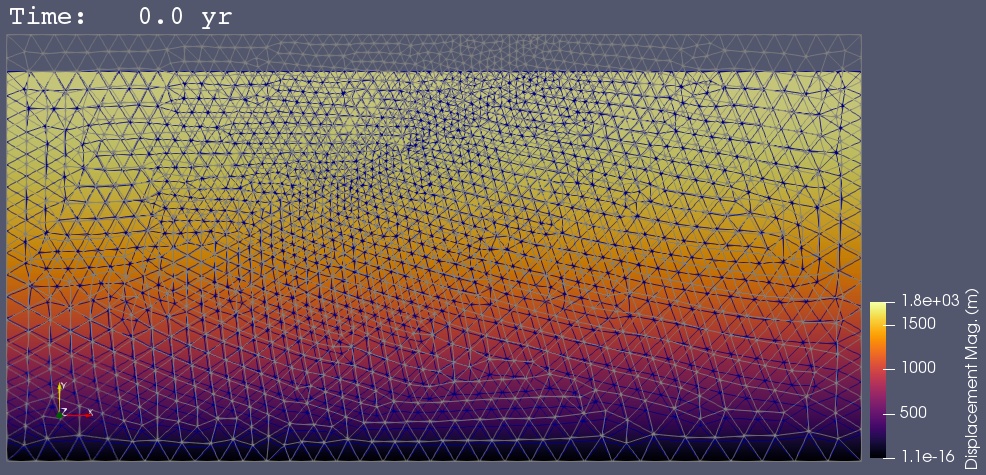Step 1: Gravitational Body Forces#
Features
Triangular cells
pylith.meshio.MeshIOPetsc
pylith.problems.TimeDependent
pylith.bc.DirichletTimeDependent
spatialdata.spatialdb.SimpleDB
spatialdata.spatialdb.ZeroDB
pylith.meshio.OutputSolnBoundary
pylith.meshio.DataWriterHDF5
Static simulation
pylith.materials.Elasticity
pylith.materials.IsotropicLinearElasticity
spatialdata.spatialdb.GravityField
Simulation parameters#
This example involves a static simulation that solves for the deformation from loading by gravitational body forces.
Fig. 75 shows the boundary conditions on the domain.
The parameters specific to this example are in step01_gravity.cfg.
Fig. 75 We apply roller boundary conditions on the lateral sides and bottom of the domain.#
We solve the static elasticity equation with gravitational body forces,
In 2D with gravitational body forces acting in the -y direction, we need to set the direction. We also increase the basis order of the displacement solution field to 2 to resolve the linear increase in stress and strain with depth. We also set the basis order of the Cauchy stress and strain derived fields for each material to 1.
[pylithapp.problem]
gravity_field = spatialdata.spatialdb.GravityField
gravity_field.gravity_dir = [0.0, -1.0, 0.0]
defaults.quadrature_order = 2
[pylithapp.problem.solution.subfields.displacement]
basis_order = 2
[pylithapp.problem.materials.slab]
derived_subfields.cauchy_strain.basis_order = 1
derived_subfields.cauchy_stress.basis_order = 1
[pylithapp.problem.materials.crust]
derived_subfields.cauchy_strain.basis_order = 1
derived_subfields.cauchy_stress.basis_order = 1
[pylithapp.problem.materials.wedge]
derived_subfields.cauchy_strain.basis_order = 1
derived_subfields.cauchy_stress.basis_order = 1
Running the simulation#
$ pylith step01_gravity.cfg
# The output should look something like the following.
>> /software/unix/py39-venv/pylith-debug/lib/python3.9/site-packages/pylith/meshio/MeshIOObj.py:44:read
-- meshiopetsc(info)
-- Reading finite-element mesh
>> /src/cig/pylith/libsrc/pylith/meshio/MeshIO.cc:94:void pylith::meshio::MeshIO::read(topology::Mesh *)
-- meshiopetsc(info)
-- Component 'reader': Domain bounding box:
(-100000, 100000)
(-100000, 0)
>> /software/unix/py39-venv/pylith-debug/lib/python3.9/site-packages/pylith/problems/Problem.py:116:preinitialize
-- timedependent(info)
-- Performing minimal initialization before verifying configuration.
>> /software/unix/py39-venv/pylith-debug/lib/python3.9/site-packages/pylith/problems/Solution.py:44:preinitialize
-- solution(info)
-- Performing minimal initialization of solution.
>> /software/unix/py39-venv/pylith-debug/lib/python3.9/site-packages/pylith/materials/RheologyElasticity.py:41:preinitialize
-- isotropiclinearelasticity(info)
-- Performing minimal initialization of elasticity rheology 'bulk_rheology'.
>> /software/unix/py39-venv/pylith-debug/lib/python3.9/site-packages/pylith/materials/RheologyElasticity.py:41:preinitialize
-- isotropiclinearelasticity(info)
-- Performing minimal initialization of elasticity rheology 'bulk_rheology'.
>> /software/unix/py39-venv/pylith-debug/lib/python3.9/site-packages/pylith/materials/RheologyElasticity.py:41:preinitialize
-- isotropiclinearelasticity(info)
-- Performing minimal initialization of elasticity rheology 'bulk_rheology'.
>> /software/unix/py39-venv/pylith-debug/lib/python3.9/site-packages/pylith/bc/DirichletTimeDependent.py:92:preinitialize
-- dirichlettimedependent(info)
-- Performing minimal initialization of time-dependent Dirichlet boundary condition 'bc_xneg'.
>> /software/unix/py39-venv/pylith-debug/lib/python3.9/site-packages/pylith/bc/DirichletTimeDependent.py:92:preinitialize
-- dirichlettimedependent(info)
-- Performing minimal initialization of time-dependent Dirichlet boundary condition 'bc_xpos'.
>> /software/unix/py39-venv/pylith-debug/lib/python3.9/site-packages/pylith/bc/DirichletTimeDependent.py:92:preinitialize
-- dirichlettimedependent(info)
-- Performing minimal initialization of time-dependent Dirichlet boundary condition 'bc_yneg'.
>> /software/unix/py39-venv/pylith-debug/lib/python3.9/site-packages/pylith/problems/Problem.py:175:verifyConfiguration
-- timedependent(info)
-- Verifying compatibility of problem configuration.
>> /software/unix/py39-venv/pylith-debug/lib/python3.9/site-packages/pylith/problems/Problem.py:221:_printInfo
-- timedependent(info)
-- Scales for nondimensionalization:
Length scale: 1000*m
Time scale: 3.15576e+09*s
Pressure scale: 3e+10*m**-1*kg*s**-2
Density scale: 2.98765e+23*m**-3*kg
Temperature scale: 1*K
>> /software/unix/py39-venv/pylith-debug/lib/python3.9/site-packages/pylith/problems/Problem.py:186:initialize
-- timedependent(info)
-- Initializing timedependent problem with quasistatic formulation.
>> /src/cig/pylith/libsrc/pylith/utils/PetscOptions.cc:235:static void pylith::utils::_PetscOptions::write(pythia::journal::info_t &, const char *, const pylith::utils::PetscOptions &)
-- petscoptions(info)
-- Setting PETSc options:
ksp_atol = 1.0e-12
ksp_converged_reason = true
ksp_error_if_not_converged = true
ksp_rtol = 1.0e-12
pc_type = lu
snes_atol = 1.0e-9
snes_converged_reason = true
snes_error_if_not_converged = true
snes_monitor = true
snes_rtol = 1.0e-12
ts_error_if_step_fails = true
ts_monitor = true
ts_type = beuler
>> /software/unix/py39-venv/pylith-debug/lib/python3.9/site-packages/pylith/problems/TimeDependent.py:139:run
-- timedependent(info)
-- Solving problem.
0 TS dt 0.01 time 0.
0 SNES Function norm 2.873918352757e-01
Linear solve converged due to CONVERGED_RTOL iterations 1
1 SNES Function norm 3.025686251687e-13
Nonlinear solve converged due to CONVERGED_FNORM_ABS iterations 1
1 TS dt 0.01 time 0.01
>> /software/unix/py39-venv/pylith-debug/lib/python3.9/site-packages/pylith/problems/Problem.py:201:finalize
-- timedependent(info)
-- Finalizing problem.
At the beginning of the output written to the terminal, we see that PyLith is reading the mesh using the MeshIOPetsc reader and that it found the domain to extend from -100,000 m to +100,000 m in the x direction and from -100,000 m to 0 in the y direction.
The output also shows the scales for nondimensionalization and the PETSc options selected by PyLith.
This simulation did not use a fault, so PyLith used the LU preconditioner.
At the end of the output written to the terminal, we see that the solver advanced the solution one time step (static simulation).
The linear solve converged after 1 iterations and the norm of the residual met the relative convergence tolerance (ksp_rtol) .
The nonlinear solve converged in 1 iteration, which we expect because this is a linear problem, and the residual met the absolute convergence tolerance (snes_atol).
Visualizing the results#
The output directory contains the simulation output.
Each “observer” writes its own set of files, so the solution over the domain is in one set of files, the boundary condition information is in another set of files, and the material information is in yet another set of files.
The HDF5 (.h5) files contain the mesh geometry and topology information along with the solution fields.
The Xdmf (.xmf) files contain metadata that allow visualization tools like ParaView to know where to find the information in the HDF5 files.
To visualize the data using ParaView or Visit, load the Xdmf files.
In Fig. 76 we use ParaView to visualize the displacement field using the viz/plot_dispwarp.py Python script.
First, we start ParaView from the examples/reverse-2d directory.
Next, we use the Python Shell to change the default exaggeration of the deformation to 5 to account for the large deformation.
>>> WARP_SCALE = 5
Finally, we run the viz/plot_dispwarp.py Python script as described in ParaView Python Scripts.
We apply the gravitational body forces to an undeformed, stress-free domain.
As a result, the vertical deformation is about 2 kilometers.

Fig. 76 Solution for Step 1. The colors of the shaded surface indicate the magnitude of the displacement, and the deformation is exaggerated by a factor of 5. The undeformed configuration is show by the gray wireframe.#

